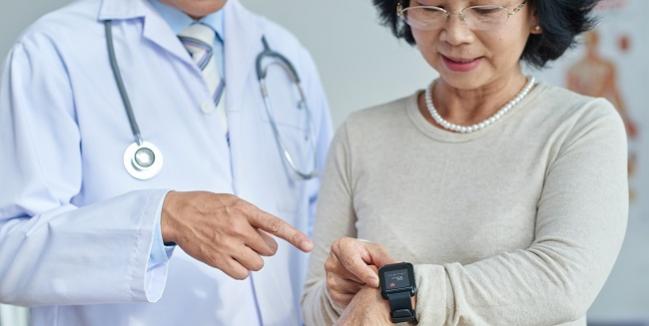Apple Watch—and a Proactive Patient—Pick Up AV Block Post-TAVR
The case demonstrates the potential of combining patient education with powerful technology, one researcher says.

A new case report is demonstrating additional potential for wearable technology—in this case, the Apple Watch—to identify high-grade atrioventricular (AV) block following TAVR.
Apple Watch (Apple, Cupertino, CA) has already been shown to detect A-fib; placing the watch in various positions may be able to create ECG readouts comparable to the standard 12-lead machines in diagnosing MI. As research into this fledging field continues to amass, so too do concerns over data privacy and changes in the patient-physician dynamic.
“The moral of the story is that we are entering into a whole new era with all the wearable and electronic [devices] and patients are starting to participate in their care by using those devices,” senior author Ron Waksman, MD (MedStar Washington Hospital Center, Washington, DC), told TCTMD.
In this specific case, recently published in the European Heart Journal with Charan Yerasi, MD (MedStar Washington Hospital Center), as lead author, a 68-year-old patient who had received TAVR a year earlier had a syncopal episode and immediately after used the ECG feature on his Apple Watch to record a single-lead reading. The patient noted that this reading, as well as readings following two similar events over the ensuing month, was different from what he was used to seeing and brought this to the attention of his cardiologist. He was ultimately diagnosed with high-grade AV block and underwent urgent biventricular pacemaker implantation.
Notably, Waksman explained, the patient who developed the left bundle branch block postoperatively had turned down a full electrophysiology study following his TAVR, although an event monitor placed after the procedure did not reveal any issues.
While information gleaned from wearables may lead to false alarms that can needlessly send patients to physicians or even to the emergency department, “on the other hand, it may be a lifesaver when people start to use it more wisely,” Waksman said, especially as those devices become more accurate. “It looks like medicine is changing, and as physicians we have to be receptive. I think it's too early to tell people to look at [their] watch and make sure [they] have [normal] rhythm and teach them, but I'm not sure that day is that far from now.”
We cannot teach them medicine, but if you see something that doesn't look right on the watch and it corresponds to some symptoms, then obviously you have to be calling me. Ron Waksman
Education will be key in ensuring patients use this added information wisely, he stressed. “Many times, when patients complain about symptoms, they don't know if it is in their head or in their heart or in their mind or whatever and they want to get some assurances. Now the threshold for them to come to an emergency room is huge or even to call into a physician and to be on the line or to get an appointment. Here, all of a sudden, you have a tool that you can look at instantaneously and just try to correlate ‘This is not the picture I've seen before, maybe there's something wrong with me.’”
Waksman pointed to the fact that while wearable devices like the Apple Watch are not labeled by any regulatory authority as medical aides, “they’re reliable” and patients are wearing them. “Physicians have to start to work together with the patients when they are using those devices and to use them as a tool to help the patients take care of themselves better, and they should not wait for labeling for all of those devices because that's going to take forever,” he said. “This is not for every medical situation and it's not for every patient. But [patients who use them] should be educated in: what does that mean and what do you do with that? And that's something that we as physicians have to play a role in. [We cannot] just ignore it.”
Of course the flipside is that physicians might feel overworked when receiving lots of unsolicited data patients might send from their wearable devices, Waksman acknowledge. “That's becoming a huge burden and there is also no compensation for this right now, so we're struggling with that,” he said. “We don't know what to do with all that information. That's a [very] heavy task that we'll have to deal with.”
Ultimately, it again goes back to patient education and enabling them to use common sense when presented with troubling information from their devices. “We cannot teach them medicine, but if you see something that doesn't look right on the watch and it corresponds to some symptoms, then obviously you have to be calling me,” Waksman advised. “It's another tool. In this specific case, this was all driven by the patient. He had the watch. We never told him to buy the watch. He is the one that made the connection. He made some complaints that were hard to be documented.”
Yael L. Maxwell is Senior Medical Journalist for TCTMD and Section Editor of TCTMD's Fellows Forum. She served as the inaugural…
Read Full BioSources
Yerasi C, O’Donoghue S, Satler LF, Waksman R. Apple Watch detecting high-grade block after transcatheter aortic valve implantation. Eur Heart J. 2019;Epub ahead of print.
Disclosures
- Waksman reports serving on the advisory board for Amgen, Boston Scientific, Cardioset, Cardiovascular Systems, Medtronic, Philips, and Pi-Cardia; serving as a consultant for Amgen, Biotronik, Boston Scientific, Cardioset, Cardiovascular Systems, Medtronic, Philips, and Pi-Cardia; receiving grant support from AstraZeneca, Biotronik, Boston Scientific, and Chiesi; serving on the speakers bureau for AstraZeneca and Chiesi; and being an investor in MedAlliance.
- Yerasi reports no relevant conflicts of interest.


Comments